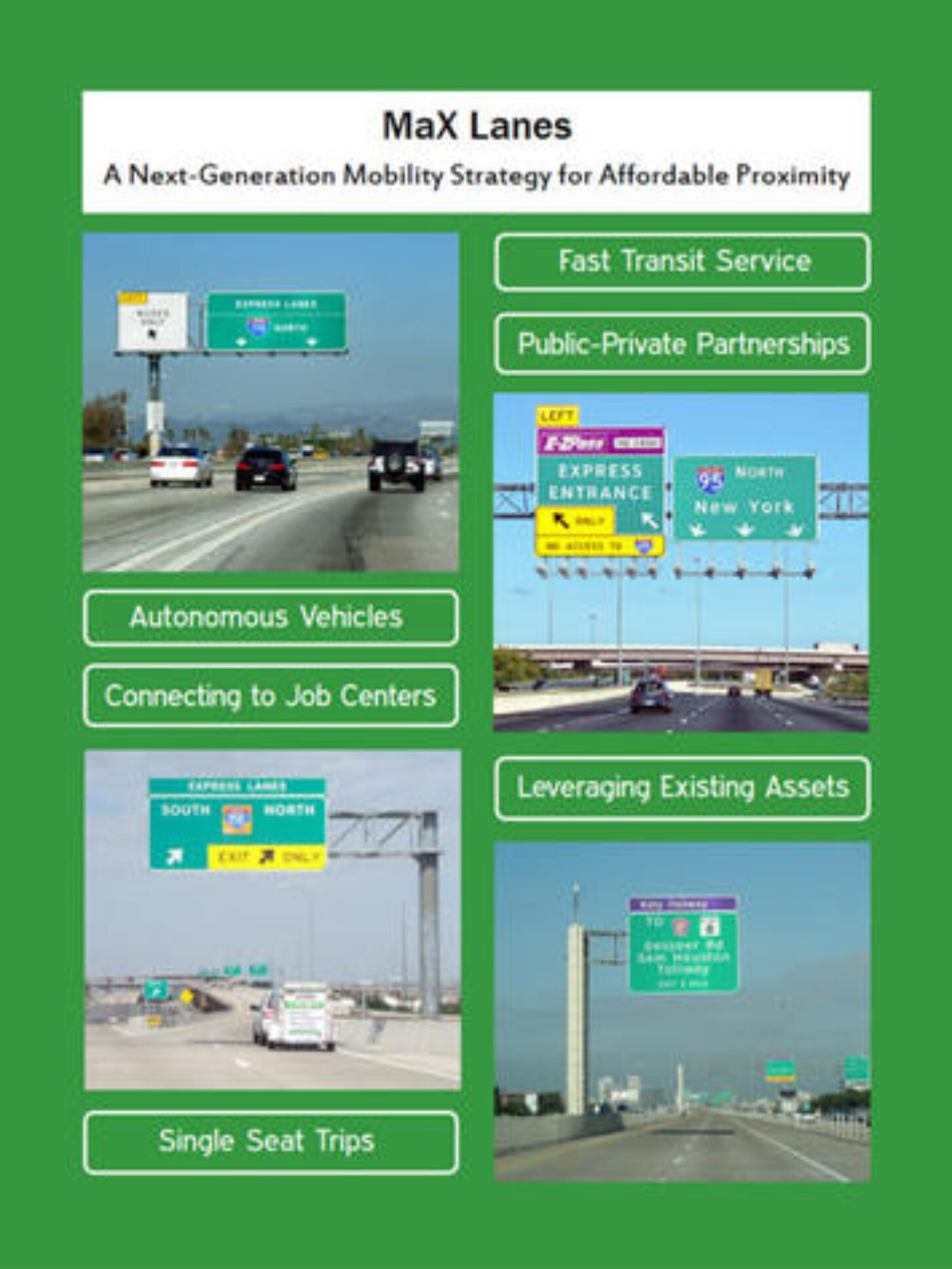
How will managed express lanes help metro Atlantans?
 What promise do metro Atlanta’s express toll lanes hold for congestion relief, mobility, quality of life and affordability?
What promise do metro Atlanta’s express toll lanes hold for congestion relief, mobility, quality of life and affordability?
In a nutshell: NewGeography.com describes the need for “affordable proximity” – enabling a growing regional population to live, work, shop and play without breaking the bank on housing or transportation costs. We need to acknowledge that in “decentralized, post-WW2 Sunbelt cities built around the car, commuter rail solutions don’t work and an alternative is needed, especially as we see autonomous vehicles on the horizon.”
The solution lies in managed express lanes (MaX lanes), which leverage existing infrastructure, writes Tory Gattis of The Center for Opportunity Urbanism. He addresses this approach in his new report, “A Next-Generation Mobility Strategy for Affordable Proximity: Moving the maximum number of people at maximum speed.” Gattis’ report includes a case study of Houston, Texas, and looks at other managed express lanes around the nation.
Georgia has two managed express toll lanes currently open: I-85 north HOT lanes and I-75 reversible express toll lanes on the southside of Atlanta. Opening next year: the I-75/575 reversible toll lanes on the northside.
As Newgeography.com explains it
This briefing explores a next-generation mobility strategy for affordable proximity: MaX Lanes (Managed eXpress Lanes) moving the maximum number of people at maximum speed and allowing direct point-to-point single-seat high-speed trips by transit buses and other shared-ride vehicles today, and autonomous vehicles in the future.
Gattis summarizes the transit benefits:
The goal would be comprehensive single-seat express commuter bus service from all parts of a metro to all the major job centers. Commuters would go to their nearest Park-and-Ride center by car or transit to find express bus options to each of the major job centers, using MaX Lanes for a highspeed, point-to-point ride and ending by circulating through the destination job center to get commuters close to their final destination without the need for transfers. When needed, commuters could use affordable shared-ride services for local “last mile” connections or to get around during the work day for lunches, errands, or meetings. McKinsey predicts that by 2025 these services may be as low as 17 to 67 cents per mile when automated, depending on how many people share the vehicle.
The report is encouraging in describing the lanes’ promise, especially if considered in the light of metro Atlanta’s soaring population and the technological advances influencing transportation policy. If nothing else, the pictures of the projects highlighted are fascinating!
– Benita Dodd

By Benita Dodd
What promise do metro Atlanta’s express toll lanes hold for congestion relief, mobility, quality of life and affordability?
In a nutshell: NewGeography.com describes the need for “affordable proximity” – enabling a growing regional population to live, work, shop and play without breaking the bank on housing or transportation costs. We need to acknowledge that in “decentralized, post-WW2 Sunbelt cities built around the car, commuter rail solutions don’t work and an alternative is needed, especially as we see autonomous vehicles on the horizon.”
The solution lies in managed express lanes (MaX lanes), which leverage existing infrastructure, writes Tory Gattis of The Center for Opportunity Urbanism. He addresses this approach in his new report, “A Next-Generation Mobility Strategy for Affordable Proximity: Moving the maximum number of people at maximum speed.” Gattis’ report includes a case study of Houston, Texas, and looks at other managed express lanes around the nation.
Georgia has two managed express toll lanes currently open: I-85 north HOT lanes and I-75 reversible express toll lanes on the southside of Atlanta. Opening next year: the I-75/575 reversible toll lanes on the northside.
As Newgeography.com explains it
This briefing explores a next-generation mobility strategy for affordable proximity: MaX Lanes (Managed eXpress Lanes) moving the maximum number of people at maximum speed and allowing direct point-to-point single-seat high-speed trips by transit buses and other shared-ride vehicles today, and autonomous vehicles in the future.
Gattis summarizes the transit benefits:
The goal would be comprehensive single-seat express commuter bus service from all parts of a metro to all the major job centers. Commuters would go to their nearest Park-and-Ride center by car or transit to find express bus options to each of the major job centers, using MaX Lanes for a highspeed, point-to-point ride and ending by circulating through the destination job center to get commuters close to their final destination without the need for transfers. When needed, commuters could use affordable shared-ride services for local “last mile” connections or to get around during the work day for lunches, errands, or meetings. McKinsey predicts that by 2025 these services may be as low as 17 to 67 cents per mile when automated, depending on how many people share the vehicle.
The report is encouraging in describing the lanes’ promise, especially if considered in the light of metro Atlanta’s soaring population and the technological advances influencing transportation policy. If nothing else, the pictures of the projects highlighted are fascinating!
Benita Dodd is vice president of the Georgia Public Policy Foundation.
